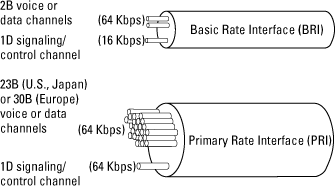
ISDN Channels
In ISDN and other Digital TDM environments, a channel generally refers
to a time slot on a transmission facility and is full-duplex (bi-directional).
There are three basic types of channels defined for data communivation
in an ISDN, differentiated by their function and bit rate.
* D Channel: It basically carries signalling information between the user and the network; may also carry user data packets. The bit rate of D channel is 16Kbps(BRI) or 64Kbps(PRI). Although its primary function is to carry user-network signalling, the transport of packet-mode data is the secondary function. It offers bit rate upto 9.6 Kbps for packet data.
* B Channel: The primary purpose of B channel is to carry the user's voice, audio, data and video signals. It can be used both for circuit switching and packet switching applications. It operates at DS-0 rate (64Kbps).
* H Channel: A user application requiring
bit rate above 64 Kbps may be obtained by using wideband channels, or H
channels. The first designated higher-rate channel is an H0 channel which
has a data rate of 384 Kbps. This is equivalent to logically grouping six
B-channels together. Typical applications that use H channels include high-speed
data, high-qualiity audio, teleconferencing, and video services.
ISDN Channel types:
|
|
|
|
|
|
|
|
|
|
|
|
|
|
|
|
|
|
|
|
Access Interfaces
An access interface is the physical connection between the user and the ISDN that allows the user to request and obtain services. ISDN defines two types of access interfaces, called the basic rate inerface (BRI) and primary rate interface (PRI). These access interfaces specify the rate at which the physical medium will operate and the number of available B, D. and H channels.
ISDN Access Interface Structures:
| Interface | Structure | Total Bit Rate |
| BRI | 2B+D16 | 192 Kbps |
| PRI -T1 | 23B+D64 | 1.544Mbps |
| PRI -E1 | 30B+D64 | 2.048Mbps |

Basic Rate interace: It
comprises two B-channels and one D-channel. The BRI D-channel always operates
at 16Kbps. The user data on BRI is 144Kbps(2*64Kbps
+ 16Kbps).

Primary rate interface: The PRI has a number of possible configurations. The most common configuration in North America and Japan is designated 23B+D. The PRI description is based on the T1 digital carrier. It operates at 1.544Mbps, of which 1.536Mbps are user data. This is called T1 PRI.
A 30B+D PRI is also defined that comprises 30 B channels, one D channel and one framing channel. Based on the E1 digital carrier, it operates at 2.048Mbps of which 1.984Mbps is user data. This is called E1 PRI.
